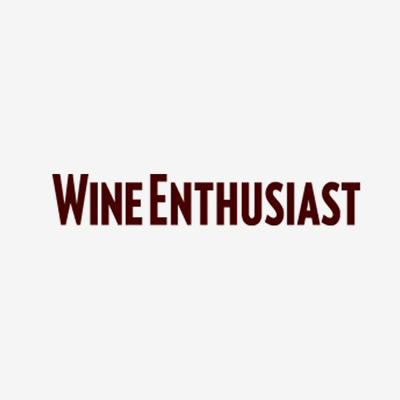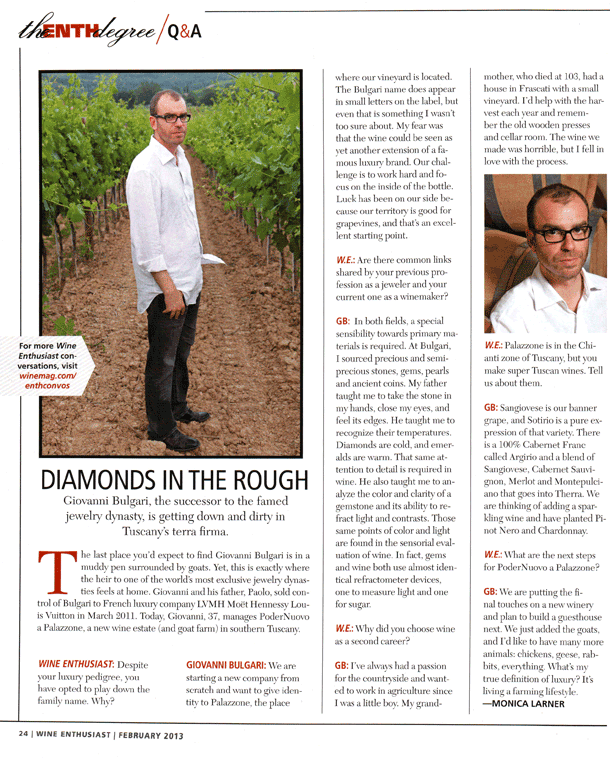Q&A with Giovanni Bulgari

Diamonds in the rough Giovanni Bulgari, the successor to the famed jewelry dynasty, is getting down and dirty in Tuscany’s terra firma.

Q&A WITH GIOVANNI BULGARI DIAMONDS IN THE ROUGH
GIOVANNI BULGARI, THE SUCCESSOR TO THE FAMED JEWELRY DYNASTY, IS GETTING DOWN AND DIRTY IN TUSCANY’S TERRA FIRMA.
By Monica Larner
The last place you’d expect to find Giovanni Bulgari is in a muddy pen surrounded by goats. Yet, this is exactly where the heir to one of the world’s most exclusive jewelry dynasties feels at home. Giovanni and his father, Paolo, sold control of Bulgari to French luxury company LVMH Moët Hennessy Louis Vuitton in March 2011. Today, Giovanni, 37, manages PoderNuovo a Palazzone, a new wine estate (and goat farm) in southern Tuscany.
Wine Enthusiast: Despite your luxury pedigree, you have opted to play down the family name. Why?
Giovanni Bulgari: We are starting a new company from scratch and want to give identity to Palazzone, the place where our vineyard is located. The Bulgari name does appear in small letters on the label, but even that is something I wasn’t too sure about. My fear was that the wine could be seen as yet another extension of a famous luxury brand. Our challenge is to work hard and focus on the inside of the bottle. Luck has been on our side because our territory is good for grapevines, and that’s an excellent starting point.
W.E.: Are there common links shared by your previous profession as a jeweler and your current one as a winemaker?
GB: In both fields, a special sensibility towards primary materials is required. At Bulgari, I sourced precious and semiprecious stones, gems, pearls and ancient coins. My father taught me to take the stone in my hands, close my eyes, and feel its edges. He taught me to recognize their temperatures. Diamonds are cold, and emeralds are warm. That same attention to detail is required in wine. He also taught me to analyze the color and clarity of a gemstone and its ability to refract light and contrasts. Those same points of color and light are found in the sensorial evaluation of wine. In fact, gems and wine both use almost identical refractometer devices, one to measure light and one for sugar.
W.E.: Why did you choose wine as a second career?
GB: I’ve always had a passion for the countryside and wanted to work in agriculture since I was a little boy. My grandmother, who died at 103, had a house in Frascati with a small vineyard. I’d help with the harvest each year and remember the old wooden presses and cellar room. The wine we made was horrible, but I fell in love with the process.
W.E.: Palazzone is in the Chianti zone of Tuscany, but you make super Tuscan wines. Tell us about them.
GB: Sangiovese is our banner grape, and Sotirio is a pure expression of that variety. There is a 100% Cabernet Franc called Argirio and a blend of Sangiovese, Cabernet Sauvignon, Merlot and Montepulciano that goes into Therra. We are thinking of adding a sparkling wine and have planted Pinot Nero and Chardonnay.
W.E.: What are the next steps for PoderNuovo a Palazzone?
GB: We are putting the final touches on a new winery and plan to build a guesthouse next. We just added the goats, and I’d like to have many more animals: chickens, geese, rabbits, everything. What’s my true definition of luxury? It’s living a farming lifestyle.



